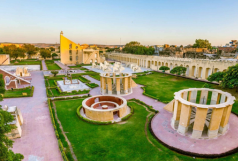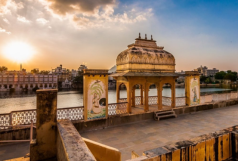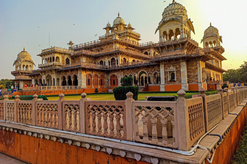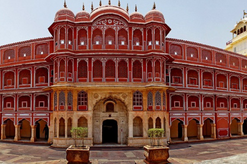Hawa Mahal in Jaipur An Architectural Marvel
Hawa Mahal, also known as the "Palace of Winds," is one of the most iconic landmarks in Jaipur, Rajasthan. This stunning palace is famous for its unique architecture, which blends Rajput and Mughal styles, and its intricate façade that captivates visitors from all over the world. In this blog, we will explore the history, design, and significance of Hawa Mahal, making it a must-visit destination during your Jaipur sightseeing tour.
History of Hawa Mahal
Built in 1799 by Maharaja Sawai Pratap Singh, the Hawa Mahal was designed by the renowned architect Lal Chand Ustad. The palace was constructed with the intention of providing royal women a space to observe the street life and festivals without being seen by the public. With its unique structure, Hawa Mahal became a symbol of the blend of Rajput and Mughal architecture, featuring intricate latticework and numerous small windows, known as "jharokhas," which allowed the cool breeze to flow through the palace, keeping it naturally ventilated.
Architecture and Design
The architecture of Hawa Mahal is truly a marvel, with a façade that resembles a giant honeycomb. The palace is five stories high, and its front is decorated with 953 small windows. These jharokhas are a masterpiece of latticework, designed to allow air to pass through and provide a cool breeze, making it a perfect refuge during the hot summers. The structure is primarily made of red and pink sandstone, which gives it its signature hue, blending beautifully with the surroundings of Jaipur.
Each floor of the palace is a part of its architectural brilliance. The first and second floors have small windows that open to the street below, while the upper floors were designed for the royal women to have an uninterrupted view of the city and festivals taking place on the streets. The structure is also adorned with intricate carvings, floral designs, and motifs that reflect the exquisite craftsmanship of the era.
Visiting Hawa Mahal: What to Expect
When you visit Hawa Mahal, you will be amazed by the grandeur and elegance of its architecture. The structure is located in the heart of Jaipur, near the City Palace and Jantar Mantar, making it a perfect stop during your Jaipur sightseeing tour. The palace offers both outdoor and indoor spaces to explore, including:
- The Ground Floor: The base of the palace consists of a large entrance with decorative arches, leading you to the inner rooms.
- The First and Second Floors: These floors are open and offer a closer look at the windows and intricate carvings that make the palace unique.
- The Upper Floors: These provide panoramic views of the surrounding cityscape and give you a chance to see the historical significance of the palace's design.
It’s also worth noting that there is a small museum inside Hawa Mahal that showcases the history and culture of Jaipur, including artifacts and historical records related to the palace.
Best Time to Visit Hawa Mahal
The best time to visit Hawa Mahal is during the cooler months of October to March, as Jaipur’s weather can be extremely hot during the summer months. Early mornings and late afternoons are ideal for visiting, as the lighting enhances the intricate details of the façade, and the temperatures are more comfortable. Additionally, visiting in the early morning will allow you to avoid the crowds and experience the peace and beauty of the palace.
Entry Fees and Timings
To visit Hawa Mahal, the entry fees are as follows:
- Indian Visitors: ₹50 (per person)
- Foreign Nationals: ₹200 (per person)
- Camera Fees: ₹50 for a regular camera, ₹100 for a video camera
The palace is open from 9:00 AM to 5:00 PM daily. However, it is advisable to check the timings before your visit, as there may be occasional changes for maintenance or special events.
Day-Wise Itinerary for Exploring Jaipur
If you're visiting Jaipur as part of a Jaipur sightseeing tour, it's essential to plan your itinerary to make the most of your time. Below is a suggested day-wise itinerary for exploring the city:
Day 1: Arrival and Jaipur City Tour
Upon arrival in Jaipur, check into your hotel and begin your sightseeing tour with a visit to the iconic Hawa Mahal. Afterward, head to the City Palace, followed by a visit to Jantar Mantar and the famous Albert Hall Museum.
Day 2: Visit Amber Fort and Jaigarh Fort
On your second day, visit the magnificent Amber Fort and its nearby Jaigarh Fort. These forts are significant landmarks in Jaipur’s history and offer beautiful views of the surrounding landscapes.
Day 3: Explore Nahargarh Fort and Jal Mahal
On the final day, explore the Nahargarh Fort for stunning views of Jaipur and visit the beautiful Jal Mahal situated in the middle of the Man Sagar Lake.
How to Reach Hawa Mahal
Hawa Mahal is located in the heart of Jaipur, making it easily accessible by various modes of transportation:
- Auto-Rickshaw or Taxi: Available throughout the city.
- Local Buses: Local buses run frequently from all parts of Jaipur.
- Private Car: You can also hire a private taxi for convenience.
Conclusion
Hawa Mahal is undoubtedly one of the most iconic and architecturally significant landmarks in Jaipur. Whether you're a history buff, architecture enthusiast, or a first-time visitor, Hawa Mahal offers an experience like no other. Don’t forget to include it in your Jaipur sightseeing tour itinerary to experience the grandeur and beauty of this architectural marvel!























